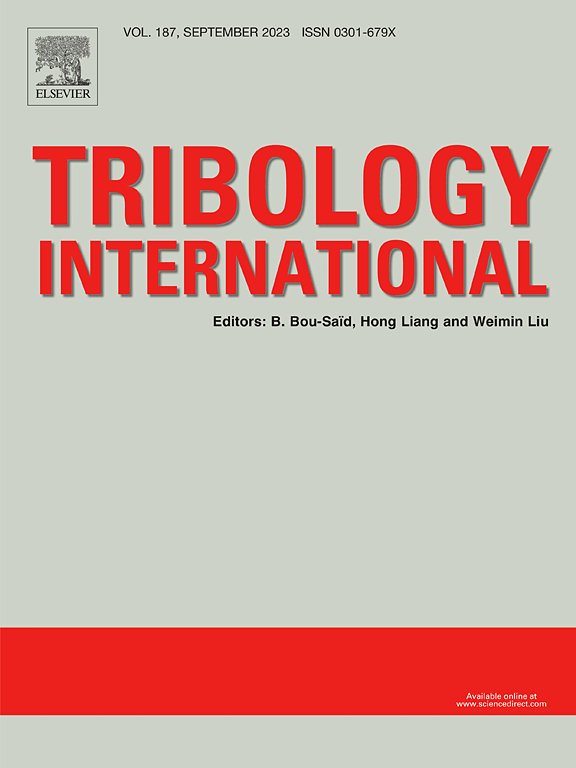Fundamentals of cooling/lubrication effect in grinding of Inconel 718 employing an inverse thermo-mechanical model
IF 6.1
1区 工程技术
Q1 ENGINEERING, MECHANICAL
引用次数: 0
Abstract
Cutting fluids are essential in grinding to control the intense heat generated at the wheel–workpiece interface. This study investigates the cooling/lubrication effect using an inverse thermo-mechanical model to support the understanding and optimization of sustainable cooling strategies. A hybrid analytical–experimental method is developed for determining the heat partition ratio and the convective heat transfer coefficient (h), which are critical to understanding thermal behavior in grinding. The inverse modeling approach considers the thermal behaviour of coolants and workpiece materials under elevated temperatures, where their thermo-physical properties differ significantly from those at room temperature. It further incorporates the effects of grinding parameters, wheel-workpiece contact length, and coolant supply conditions. Additionally, chemical reactions in the grinding zone, which can either absorb or release heat, are accounted for, further influencing heat transfer dynamics. The model is applied to evaluate several eco-friendly cooling/lubrication techniques, including cryogenic liquid nitrogen, carbon dioxide, minimum quantity lubrication (MQL), and their hybrid combinations, and compared to conventional flood and dry grinding. Key performance indicators such as grinding forces, temperature, surface finish, and elemental composition are analyzed. A generalized formula for the heat partition ratio is proposed based on the inverse method, enabling consistent evaluation of thermal effects across different cooling conditions. This integrated modeling approach enhances the understanding of coolant behavior in realistic grinding environments and supports the transition toward sustainable, high-efficiency manufacturing by guiding the selection and optimization of environmentally friendly cooling/lubrication methods.
基于逆热力学模型的Inconel 718磨削冷却/润滑效应的基本原理
在磨削过程中,切削液是控制砂轮-工件界面产生的强烈热量所必需的。本研究使用逆热力学模型来研究冷却/润滑效应,以支持对可持续冷却策略的理解和优化。提出了一种分析与实验相结合的方法来确定磨削过程中的传热分配比和对流换热系数h,这是了解磨削过程热行为的关键。逆建模方法考虑了冷却剂和工件材料在高温下的热行为,在高温下,它们的热物理性质与室温下的热物理性质有很大不同。它进一步纳入了磨削参数、砂轮-工件接触长度和冷却剂供应条件的影响。此外,研磨区的化学反应,可以吸收或释放热量,被考虑在内,进一步影响传热动力学。该模型被用于评估几种环保冷却/润滑技术,包括低温液氮、二氧化碳、最小量润滑(MQL)及其混合组合,并与传统的洪水和干磨进行了比较。关键性能指标,如磨削力,温度,表面光洁度和元素组成进行了分析。提出了一种基于逆方法的热分配比的广义公式,使不同冷却条件下的热效应评估一致。这种集成建模方法增强了对现实磨削环境中冷却剂行为的理解,并通过指导环境友好型冷却/润滑方法的选择和优化,支持向可持续、高效制造的过渡。
本文章由计算机程序翻译,如有差异,请以英文原文为准。
求助全文
约1分钟内获得全文
求助全文
来源期刊

Tribology International
工程技术-工程:机械
CiteScore
10.10
自引率
16.10%
发文量
627
审稿时长
35 days
期刊介绍:
Tribology is the science of rubbing surfaces and contributes to every facet of our everyday life, from live cell friction to engine lubrication and seismology. As such tribology is truly multidisciplinary and this extraordinary breadth of scientific interest is reflected in the scope of Tribology International.
Tribology International seeks to publish original research papers of the highest scientific quality to provide an archival resource for scientists from all backgrounds. Written contributions are invited reporting experimental and modelling studies both in established areas of tribology and emerging fields. Scientific topics include the physics or chemistry of tribo-surfaces, bio-tribology, surface engineering and materials, contact mechanics, nano-tribology, lubricants and hydrodynamic lubrication.
 求助内容:
求助内容: 应助结果提醒方式:
应助结果提醒方式:


